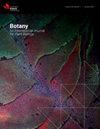Observations on the curvature of Physcomitrium patens (Hedw.) Mitt. and Funaria hygrometrica (Hedw.) caulonemal filaments
IF 1.3
4区 生物学
Q3 PLANT SCIENCES
引用次数: 0
Abstract
Botany, Ahead of Print.Light-grown, whole gametophytic colonies of Physcomitrium (formerly Physcomitrella) patens (Hedw.) Mitt. exhibit a spiral morphology resulting from the strongly coordinated curvature of the population of peripheral caulonemal filaments. The direction of curvature is predominantly clockwise when cultures are illuminated from above and anticlockwise when illuminated from below. In P. patens, side branch initials (SBIs) emerge from caulonemal subapical cells on the outside of the curve. By contrast, the curvature of caulonemata of Funaria hygrometrica is predominantly anticlockwise when colonies are illuminated from above and clockwise when illuminated from below. In F. hygrometrica, SBIs emerge from caulonemal subapical cells on the inside of the curve. We have discounted a role for gravity in these phenomena and discuss several other possible mechanistic explanations. We also document for the first time thigmotropism of protonemata of P. patens.
对Physcomitrium patens (Hedw.) Mitt.和Funaria hygrometrica (Hedw.) 茎丝弯曲的观察
植物学》,印刷前。 Physcomitrium(原名 Physcomitrella)patens (Hedw.) Mitt.在光照下生长的整个配子体菌落呈现出螺旋状形态,这是由于外围茎丝群体强烈协调弯曲造成的。从上方照射培养物时,弯曲方向主要是顺时针方向,从下方照射时则是逆时针方向。在 P. patens 中,侧枝初始(SBI)出现在曲线外侧的茎基部近顶端细胞中。相比之下,从上方照射菌落时,Funaria hygrometrica 的茎基部主要呈逆时针方向弯曲,而从下方照射时则呈顺时针方向弯曲。在 F. hygrometrica 中,SBI 从位于曲线内侧的茎基部顶下细胞中出现。我们否定了重力在这些现象中的作用,并讨论了其他几种可能的机理解释。此外,我们还首次记录了荷兰鼠李原生质体的thigmotropism。
本文章由计算机程序翻译,如有差异,请以英文原文为准。
求助全文
约1分钟内获得全文
求助全文
来源期刊

Botany
生物-植物科学
CiteScore
2.20
自引率
9.10%
发文量
48
期刊介绍:
Botany features comprehensive research articles and notes in all segments of plant sciences, including cell and molecular biology, ecology, mycology and plant-microbe interactions, phycology, physiology and biochemistry, structure and development, genetics, systematics, and phytogeography. It also publishes methods, commentary, and review articles on topics of current interest, contributed by internationally recognized scientists.
 求助内容:
求助内容: 应助结果提醒方式:
应助结果提醒方式:


